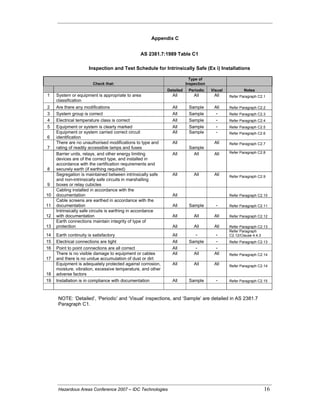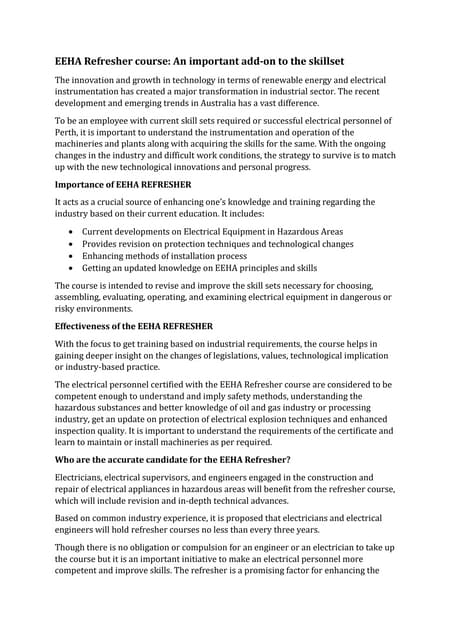The Best Strategy To Use For Roar Solutions
The Best Strategy To Use For Roar Solutions
Blog Article
9 Simple Techniques For Roar Solutions
Table of ContentsThe Definitive Guide for Roar SolutionsThe Roar Solutions DiariesAn Unbiased View of Roar Solutions
In order to shield installments from a prospective explosion an approach of analysing and classifying a possibly dangerous area is called for. The function of this is to ensure the proper choice and installation of devices to ultimately protect against an explosion and to ensure security of life.
(https://www.4shared.com/u/m0RNXdsL/thomascarrillo4740.html)
No devices must be mounted where the surface area temperature level of the equipment is higher than the ignition temperature level of the provided threat. Below are some common dust harmful and their minimum ignition temperature. Coal Dirt 380C 225C Polythene 420C (thaws) Methyl Cellulose 420C 320C Starch 460C 435C Flour 490C 340C Sugar 490C 460C Grain Dirt 510C 300C Phenolic Material 530C > 450C Aluminium 590C > 450C PVC 700C > 450C Residue 810C 570C The chance of the threat existing in a concentration high enough to trigger an ignition will certainly differ from place to place.
In order to categorize this risk a setup is split into areas of risk depending upon the quantity of time the unsafe is present. These locations are described as Zones. For gases and vapours and dusts and fibres there are 3 areas. Area 0 Zone 20 A harmful atmosphere is highly likely to be present and may exist for lengthy periods of time (> 1000 hours per year) or perhaps continually Zone 1 Zone 21 An unsafe ambience is feasible but unlikely to be existing for extended periods of time (> 10 450 C [842 F] A category of T6 indicates the minimal ignition temperature is > 85 C [185 F] Hazardous area electric devices perhaps created for use in greater ambient temperature levels. This would certainly suggested on the rating plate e.g. EExe II C T3 Ta + 60C( This means at 60C ambient T3 will certainly not be exceeded) T1 T1, T2, T3, T4, T5, T6 T2 T2, T3, T4, T5, T6 T3 T3, T4, T5, T6 T4 T4, T5, T6 T5 T5, T6 T6 T6 A T Course rating of T1 suggests the maximum surface temperature level generated by the tool at 40 C is 450 C. Assuming the linked T Course and Temperature score for the tools are proper for the area, you can always use a tool with an extra rigorous Department ranking than required for the area. There isn't a clear response to this inquiry. It truly does depend on the sort of tools and what repairs need to be accomplished. Devices with details test procedures that can't be executed in the area in order to achieve/maintain third party score. Have to return to the factory if it is prior to the equipment's service. Field Repair Service By Authorised Employee: Difficult testing might not be required nevertheless specific procedures may require to be adhered to in order for the equipment to preserve its 3rd party ranking. Authorized personnel need to be used to carry out the job correctly Repair work should be a like for like substitute. New part must be taken into consideration as a direct substitute requiring no unique screening of the tools after the repair is full. Each piece of tools with an unsafe rating ought to be examined separately. These are described at a high level listed below, but also for more comprehensive information, please refer straight to the guidelines.
The 15-Second Trick For Roar Solutions
The equipment register is a detailed data source of tools documents that includes a minimum set of fields to recognize each thing's location, technological criteria, Ex category, age, and ecological information. This information is critical for tracking and taking care of the equipment properly within hazardous areas. In contrast, for routine or RBI tasting assessments, the grade will be a mix of In-depth and Close inspections. The ratio of Thorough to Close assessments will certainly be identified by the Tools Risk, which is examined based upon ignition risk (the chance of a source of ignition versus the chance of a combustible atmosphere )and the dangerous location category
( Zone 0, 1, or 2). This variation will additionally affect the resourcing requirements for work prep work. As soon as Lots are defined, you can establish tasting plans based on the sample size of each Great deal, which describes the variety of arbitrary equipment products to be checked. To establish the required sample dimension, 2 facets require to be reviewed: the dimension of the Whole lot and the classification of evaluation, which shows the level of initiative that should be used( decreased, typical, or boosted )to the assessment of the Whole lot. By incorporating the group of examination with the Whole lot size, you can after that go to these guys establish the ideal rejection standards for an example, meaning the allowed variety of damaged things located within that example. For more details on this process, please describe the Power Institute Standards. The IEC 60079 conventional advises that the optimum period in between evaluations ought to not surpass three years. EEHA examinations will certainly also be carried out outside of RBI projects as part of set up maintenance and devices overhauls or repair work. These examinations can be credited towards the RBI sample sizes within the impacted Lots. EEHA inspections are conducted to recognize mistakes in electrical devices. A weighted racking up system is crucial, as a single tool might have several faults, each with varying levels of ignition threat. If the consolidated rating of both assessments is less than two times the fault rating, the Lot is regarded acceptable. If the Whole lot is still considered inappropriate, it must go through a full examination or reason, which may activate stricter assessment protocols. Accepted Whole lot: The causes of any kind of faults are identified. If a common failing setting is discovered, additional equipment may call for inspection and fixing. Mistakes are identified by severity( Security, Integrity, Housekeeping ), ensuring that urgent concerns are assessed and dealt with quickly to minimize any influence on safety or operations. The EEHA database need to track and record the lifecycle of mistakes in addition to the corrective actions taken. Carrying out a durable Risk-Based Examination( RBI )strategy is critical for guaranteeing compliance and security in taking care of Electrical Equipment in Hazardous Areas( EEHA) (hazardous area course). Automated Fault Scoring and Lifecycle Monitoring: Effortlessly take care of mistakes and track their lifecycle to improve inspection accuracy. The intro of this assistance for risk-based evaluation better reinforces Inspectivity's placement as a best-in-class solution for regulatory conformity, along with for any kind of asset-centric examination usage case. If you are interested in finding out more, we invite you to ask for a demo and uncover just how our option can transform your EEHA management processes.
The Main Principles Of Roar Solutions

In regards to eruptive threat, a hazardous location is an atmosphere in which an explosive atmosphere exists (or might be expected to be present) in amounts that need special precautions for the building, installation and use devices. eeha certificate. In this short article we check out the challenges encountered in the work environment, the risk control actions, and the required expertises to work securely
It is a repercussion of modern-day life that we produce, save or manage a series of gases or liquids that are considered flammable, and a variety of dirts that are deemed flammable. These materials can, in certain problems, create explosive ambiences and these can have significant and awful repercussions. Many of us know with the fire triangular eliminate any among the 3 components and the fire can not occur, however what does this mean in the context of hazardous locations? When breaking this down into its most basic terms it is essentially: a combination of a particular amount of release or leak of a certain substance or product, combining with ambient oxygen, and the presence of a resource of ignition.
In a lot of circumstances, we can do little about the degrees of oxygen in the air, but we can have substantial influence on sources of ignition, for instance electric devices. Unsafe areas are documented on the unsafe area category illustration and are determined on-site by the triangular "EX" indication. Below, among various other crucial information, zones are split right into three types depending on the risk, the possibility and duration that an explosive environment will exist; Area 0 or 20 is considered the most hazardous and Zone 2 or 22 is deemed the least.
Report this page